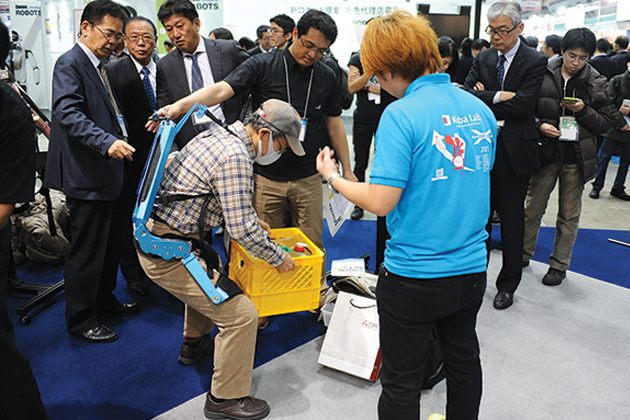This post first appeared on Risk Management Magazine. Read the original article.

Skilled labor will always be the most valuable tool of the construction trade, but technology is increasingly playing a role in how the work gets done. New devices offer safety and procedural enhancements, helping the construction industry address two of its greatest challenges: a labor shortage and high rates of worker injury and fatality.
These advances come at a fortuitous time. A 2015 Associated General Contractors of America survey revealed that nearly 80% of construction businesses had difficulty finding qualified skilled labor. At the same time, the industry faces grim fatality statistics. Construction once again topped the Bureau of Labor Statistics’ Census of Fatal Occupational Injuries list with 937 deaths in 2015, a number that has steadily increased over the past few years.
Industry injuries and deaths are poised to rise even further as the number of safety inspections drops. A study by the New York Committee for Occupational Safety & Health showed that construction-related deaths in New York City alone increased 47% in 2015 as the number of safety inspections by the federal Occupational Safety and Health Administration (OSHA) and the state fell 27%, largely due to a decrease in the number of OSHA inspectors.
The rise in industry fatalities underscores the importance of technology to improve safety. It is important to note, however, that no matter how many issues technology can address, nothing replaces a true, organization-wide safety culture. Companies relying on technology should always consider what will happen if that technology fails and have appropriate backup procedures in place. The industry must balance innovation with other safety measures to maximize technology without overly depending upon it.
Nevertheless, technology is evolving rapidly and the following tools show particular promise for improving construction safety:
Handheld Mobile Devices
Safety is now in the hands of all employees. While the use of mobile phones on construction sites can be a major distraction for employees, an abundance of safety apps targeted toward the construction industry have given managers and employees an additional arsenal of safety tools. Mobile project management apps can perform such important tasks as detecting and logging safety hazards, tracking OSHA requirements and safety incidents and determining the heat index on job sites. Apps can also detect falls and alert emergency personnel.
Drones
Already used in construction for data collection, drones can provide safety buffers in high-hazard areas and dangerous situations. Sending drones into these areas rather than humans is advantageous for assessing damage and planning emergency response. As drone technology evolves, there are also benefits when it comes to process since monitoring large footprint projects via drone can provide huge time savings and efficiencies.
Wearables
Wearable devices offer real-time monitoring of workers’ vital signs, and can alert them to the presence of volatile organic compound (VOC) gases and other environmental dangers. Safety zone mapping used in coordination with these devices can further protect workers by signaling when they are entering hot zones. In addition to significantly reducing accidents and providing data to improve site conditions, wearables can also cut health care costs by reducing health risks like cancer, respiratory problems, dermatitis and damage from noise pollution.
Exoskeletons
Piloted first in health care to boost mobility for people suffering from paralysis, exoskeletons are giving construction workers superhero strength and mobility in extreme work environments. These devices strap onto workers’ bodies and transfer much of the weight from repetitive tasks such as moving pallets or lifting screwdrivers, allowing them to use less energy to manipulate objects. The possibilities here include reducing injuries and increasing productivity, strength and dexterity.
Virtual Reality
Virtual reality began as an appealing novelty, but is now a usable tool for the construction industry. Replicating real physical environments enables workers to recreate simulations of hazardous tasks and areas, review overall building design software solutions and identify proper safety methods. Virtual reality presents both training and safety opportunities, with more benefits to come as the technology matures.
Autonomous Vehicles
The use of autonomous vehicles in the construction industry is on the rise. Vehicle accidents are a serious concern on construction sites, and driverless vans, pick-up trucks and other heavy equipment can help protect workers from these dangers.
Predictive analytics
Companies are beginning to leverage predictive analytics to understand and plan for safety risks. Proven more effective than traditional trend analysis, the approach is rapidly becoming a vital tool in safety programs. Data enables the industry to stop being reactive to accidents in the workplace and instead use predictive models to proactively establish preventative measures.
Technological innovation is rapidly changing the face of the construction industry. Possibilities that just yesterday seemed beyond imagination are more commonplace today. The machines we once feared might replace people are helping rather than hurting our workforce, taking on risky jobs and working in dangerous areas. From robots that can assist with heavy lifting to devices that go where no human could safely go, emerging innovation offers countless opportunities for the industry.
While it is exciting to consider all the possibilities inherent in technological innovation, a culture of safety must always remain a priority for any organization. With the proper combination of technology-enabled initiatives, backup measures and thoughtful oversight, the construction industry’s future promises to be safer than ever before

